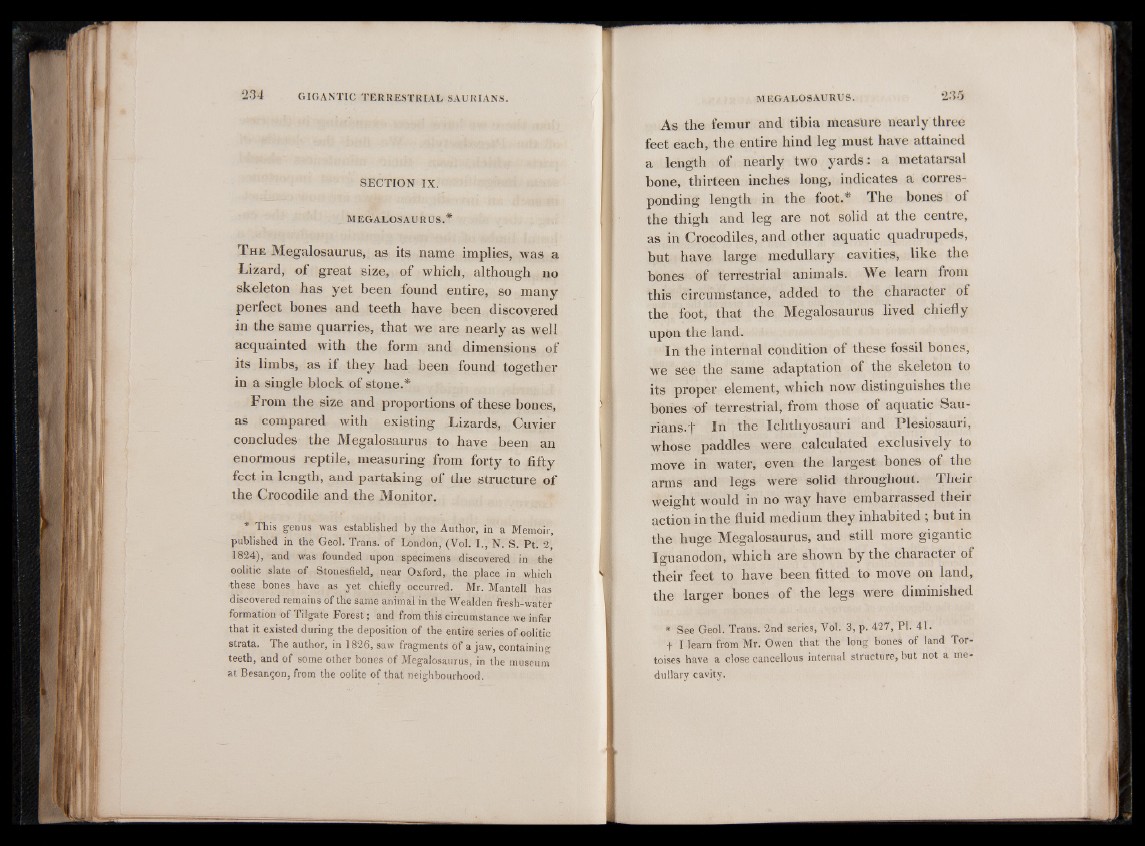
SECTION IX.
MEGALOSAURUS.*
The Megalosaurus, as its name implies, was a
Lizard, of great size, of which, although no
skeleton has yet been found entire, so many
perfect bones and teeth have been discovered
in the same quarries, that we are nearly as well
acquainted with the form and dimensions of
its limbs, as if they had been found together
in a single block of stone.*
From the size and proportions of these bones,
as compared with existing Lizards, Cuvier
concludes the Megalosaurus to have been an
enormous reptile, measuring from forty to fifty
feet in length, and partaking of the structure of
the Crocodile and the Monitor.
* This genus was established by the Author, in a Memoir,
published in the Geol. Trans, of London, (Vol. I., N. S. Pt. 2,
1824), and was founded upon specimens discovered in the
oolitic slate of Stonesfield, near Oxford, the place in which
these bones have as yet chiefly occurred. Mr. Mantell has
discovered remains of the same animal in the Wealden fresh-water
formation of Tilgate Forest ; and from this circumstance we infer
that it existed during the deposition of the entire series of oolitic
strata. The author, in 1826, saw fragments of a jaw, containing
teeth, and of some other bones of Megalosaurus, in the museum
at Besançon, from the oolite of that neighbourhood.
As the femur and tibia measure nearly three
feet each, the entire hind leg must have attained
a length of nearly two yards: a metatarsal
bone, thirteen inches long, indicates a corresponding
length in the foot.* The bones of
the thigh and leg are not solid at the centre,
as in Crocodiles, and other aquatic quadrupeds,
but have large medullary cavities, like the
bones of terrestrial animals. We learn from
this circumstance, added to the character of
the foot, that the Megalosaurus lived chiefly
upon the land.
In the internal condition of these fossil bones,
we see the same adaptation of the skeleton to
its proper element, which now distinguishes the
bones -of terrestrial, from those of aquatic Sau-
rians-t In the Ichthyosauri and Plesiosauri,
whose paddles were calculated exclusively to
move in water, even the largest bones of the
arms and legs were solid throughout. Their
weight would in no way have embarrassed their
action in the fluid medium they inhabited ; but in
the huge Megalosaurus, and still more gigantic
Iguanodon, which are shown by the character of
their feet to have been fitted to move on land,
the larger bones of the legs were diminished
* See Geol. Trans. 2nd series, Vol. 3, p. 427, PI. 41.
f I learn from Mr. Owen that the long bones of land Tortoises
have a close cancellous internal structure, but not a medullary
cavity.